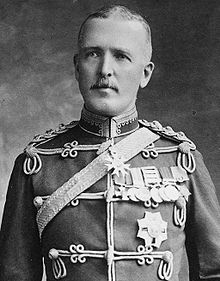James Willcocks
Sir James Willcocks GCB , GCMG , KCSI , DSO (born April 1, 1857 in Baraut , Meerut District , British India , † December 18, 1926 in Bharatpur ) was a British officer, most recently a general , who served mainly in India and Africa and led the Indian Corps on the Western Front in World War I until 1915 .
Life
Willcocks was born the son of an officer in the British East India Company and the younger brother of William Willcocks . He was educated in England and trained as an officer at the Royal Military College Sandhurst , as which he was inducted into the 100th (Prince of Wales's Royal Canadian) Regiment of Foot in 1878 . He served in 1879/80 as a supply officer in the Second Anglo-Afghan War , then in the border region of Wasiristan . In 1884 he was promoted to captain and assigned to the Army Transport Department in Assam . From 1885 to 1886 he served during the Mahdi uprising in Sudan and from 1886 to 1889 in Burma , for which he received the Distinguished Service Order . In 1887 he became an adjutant of the 1st Battalion of the Prince of Wales's Leinster Regiment (Royal Canadians) . From 1889 to 1890 he served as an intelligence officer during the Chin Lushai expedition and in 1891 in the Manipur expedition.
In 1897 he became assistant adjutant general of the Tochi Field Force in India and later that year deputy commander of the West African Frontier Force (WAFF) under Frederick Lugard with the temporary rank of Lieutenant Colonel . On the New Year of 1899 he was accepted as a Companion in the Order of St. Michael and St. George , in the same year he followed Lugard as commander of the WAFF. In the Ashanti War of 1900 he was known for his relief from Kumasi as commander of the Ashanti Field Force .
After a brief assignment in the Second Boer War in 1902, he was ordered back to India, where he was commander of the Nowshera brigade with the temporary rank of brigadier-general . He held this post until 1907. In 1908 he served in the Zakka-Khel expedition on the north-western border of British India, in which he commanded a unit the size of a division. In 1910 he received command of the Indian Northern Army with the rank of lieutenant general .
On September 5, 1914, he was appointed commander of the Indian Corps intended for use in France. With this he fought in 1914 during the " Race to the Sea " in the battles of La Bassée , Messines and Armentières . In 1915 the corps was used in the battles of Neuve-Chapelle , Ypres , Aubers Ridge and Festubert. During the preparations for the Battle of Loos on September 3, Willcocks was severely criticized by his immediate superior Douglas Haig , the Commander-in-Chief of the 1st Army , in the presence of all high army officers and thereupon offered his resignation, which Haig immediately accepted . His former corps was withdrawn from France after the battle.
Willcocks' long and successful military career came to an abrupt end. In 1917 he was appointed governor of Bermuda , which he remained until 1922. He spent the last years of his life in India again, where he died in 1926.
Fonts
- From Kabul To Kumassi. Twenty Four Years of Soldiering and Sport. (1904)
- With the Indians in France. (1920)
- The Romance of Soldiering & Sport. (1925)
literature
- Gordon Corrigan: Sepoys in the Trenches: The Indian Corps on the Western Front, 1914-1915. Spellmount, 1999, ISBN 1-86227-054-6 .
Web links
- Career dates at Liddell Hart Center for Military Archives , King's College London
| predecessor | Office | successor |
|---|---|---|
| George Bullock |
Governor of Bermuda 1917–1922 |
JJ Asser |
| personal data | |
|---|---|
| SURNAME | Willcocks, James |
| BRIEF DESCRIPTION | British general |
| DATE OF BIRTH | April 1, 1857 |
| PLACE OF BIRTH | Baraut , Meerut District , British India |
| DATE OF DEATH | December 18, 1926 |
| Place of death | Bharatpur |

